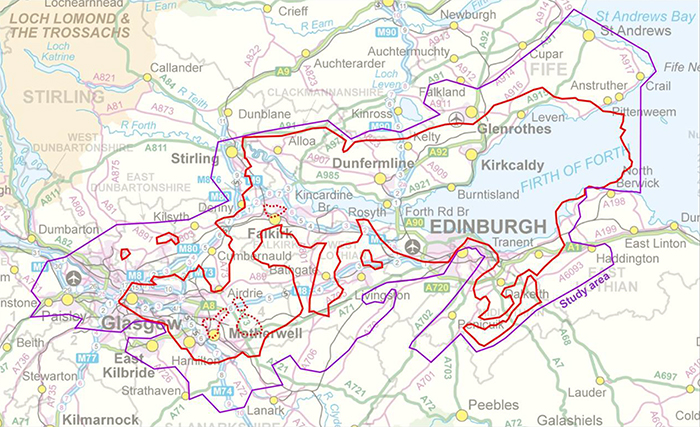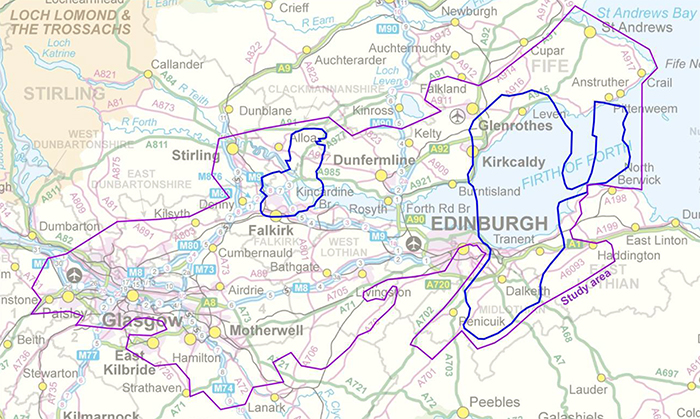The Carboniferous shales of the Midland Valley of Scotland: geology and resource estimation
30/06/2014 By BGS Press
The British Geological Survey (BGS) in association with the Department of Energy and Climate Change (DECC) has completed an estimate for the amount of shale gas and oil in the Midland Valley of Scotland. The estimate is in the form of a range to reflect geological uncertainty. The range of shale gas in place is estimated to be between 49.4 and 134.6 trillion cubic feet (tcf), with the central estimate for the resource being 80.3 tcf. The range of shale oil in place is estimated to be between 3.2 and 11.2 billion barrels (bbl), with the central estimate for the resource being 6.0 bbl.
The relatively complex geology and limited amount of good quality constraining data (seismic reflection and borehole) result in a higher degree of uncertainty to the Midland Valley of Scotland shale gas and shale oil resource estimation than the previous Bowland-Hodder and Weald Basin studies. The prospective shale intervals occur within a stacked rock sequence; individually shales are thinner than in many unconventional gas and oil systems worldwide.

Area considered prospective for oil-mature Carboniferous shale (in blue), Midland Valley of Scotland. Contains Ordnance Survey data ©Crown copyright 2014.
The figure for both shale gas and shale oil represent the total amount of gas and oil present in the rocks. Reserve and recovery estimation is not possible at this stage; in order to estimate the shale gas and oil reserves, drilling and testing of new wells will be required to understand if commercial production rates would be achieved. Development of shale gas and oil in the Midland Valley of Scotland will also be strongly controlled by the depth of prospective shales relative to abandoned deep coal mine workings and the presence of pre-existing geological faults.
Shale gas and oil clearly has potential in Britain but it will require geological and engineering expertise, investment and protection of the environment. It will also need organisations like the BGS to play their part in providing up to date and accurate information on resources and the environment to the public, industry and Government.
For further details or to arrange media interviews please contact:
Sarah Nice, BGS Press Office, Keyworth, Nottingham, NG12 5GG
Office: +44 (0)115 936 3605 Mobile: +44 (0)7989 115657
E-mail: sebr@bgs.ac.uk Twitter @Sarahnice1
Notes for Editors
The following are available for interview:
- Mr Ed Hough, British Geological Survey
For additional information go to: www.bgs.ac.uk/shalegas
Photographs are available from our ftp server: ftp://ftp.bgs.ac.uk/pubload/bgspress/shalegasresource/MidlandValleyScotland/
Free for media use with this acknowledgement: British Geological Survey©NERC
The British Geological Survey
The British Geological Survey (BGS), a component body of the Natural Environment Research Council (NERC), is the nation’s principal supplier of objective, impartial and up-to-date geological expertise and information for decision making for governmental, commercial and individual users. The BGS maintains and develops the nation’s understanding of its geology to improve policy making, enhance national wealth and reduce risk. It also collaborates with the national and international scientific community in carrying out research in strategic areas, including energy and natural resources, our vulnerability to environmental change and hazards, and our general knowledge of the Earth system. More about the BGS can be found at www.bgs.ac.uk.
The Natural Environment Research Council
The Natural Environment Research Council (NERC) is the UK’s main agency for funding and managing world-class research, training and knowledge exchange in the environmental sciences. It coordinates some of the world’s most exciting research projects, tackling major issues such as climate change, food security, environmental influences on human health, the genetic make-up of life on earth, and much more. NERC receives around £300 million a year from the government’s science budget, which it uses to fund research and training in universities and its own research centres. www.nerc.ac.uk


